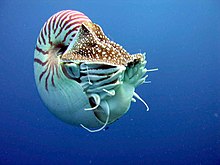The Palau nautilus (Nautilus belauensis) is a nautiloid mainly found off of Palau in the Western Carolines.[2] It can be found on fore reef slopes,[3] at depths of 95m-504m (311'-1,653'), though typically preferring a range of 150m-300m (492'-984'), where water temperatures stay around 16.6 °C (61.88°F) and do not go much lower than 9.4 °C (48.92°F).[4] N. belauensis are highly mobile, epibenthic scavengers and opportunistic predators which rely mostly on scent for finding food.[4] They are active both diurnally and nocturnally within their preferred depth ranges,[4] although most shallow-water incursions are, generally, nocturnal events that coincide with greatly diminished fish activities.[4]
| Nautilus belauensis | |
|---|---|

| |
| Nautilus belauensis in Palau | |
| Scientific classification | |
| Domain: | Eukaryota |
| Kingdom: | Animalia |
| Phylum: | Mollusca |
| Class: | Cephalopoda |
| Subclass: | Nautiloidea |
| Order: | Nautilida |
| Family: | Nautilidae |
| Genus: | Nautilus |
| Species: | N. belauensis
|
| Binomial name | |
| Nautilus belauensis Saunders, 1981
| |
Anatomy
editN. belauensis' shell is similar to that of N. pompilius, but it is distinguished by its larger mean mature shell diameter and shell weight.[5] Its shell characteristic pattern consists of bifurcating brown to red stripes that extend from the umbilicus to the venter without coalescing across the venter[5] with delicate, longitudinally crenulated ridges[2] that produce a distinctive, concentrically lirate pattern.[2] It can also be distinguished from N. pompilius by its inwardly sloping umbilical walls and evenly rounded umbilical shoulder.[6] The shell is also distinguishable by the presence of longitudinally crenulated shell sculpture, and a broadly triangular central rachidian radular tooth and a lack of umbilical callus.[5] Fresh shells were also found to implode at 680-789m depth equivalent pressures.[4]
Development
editAt the immature/juvenile stage, the Palau nautilus' shell is covered in colored bands.[3] Its body chamber is covered by a thick, gelatinous, and slippery periostracum.[3] As it reaches the sub mature stage, most of its body chamber is white but with thin margins.[3] However, it still lacks a black layer that develops upon maturity.[3]
Maturity in the Palau nautilus is reached when there is a rapid decrease in growth rate until there is no additional growth.[3] The body chamber shell wall thickens with deposition of a black layer along the apertural margin and the accentuation of the hyponomic and ocular sinuses.[3] The exterior body chamber lacks colour banding.[3] The last septum is thickened but has a reduced volume in the final chamber.[3] There are usually around 35 septa in the shell.[2] The maximum observed range in shell sizes extends from 180mm to 239mm in diameter[5] with the umbilical diameter taking up 16% of the shell diameter.[6] The Palau nautilus can live for 5–10 years after reaching maturity and have a life span that may range beyond 20 years.[3]
Behaviour
editThe Palau nautilus is able to traverse across a wide range of temperatures and great lateral distances in short periods of time.[7] It is also able to survive in warm water up to 30 °C for tens of hours up to several days.[4] It typically migrates from deeper water into shallower water following sunset and returns to the deep before sunlight.[7] It is also able to travel an average distance from 0.45 km per day over 322 days up to 0.8 km per day over 5 days.[7]
Gallery
edit-
N. belauensis seen from the front, showing the hyponome
-
Palau nautilus viewed from above
-
Diver with Palau nautilus showing size of a typical captured specimen
-
Close-up view of the eye of the Palau nautilus
-
View of a Palau nautilus from the side
-
A cage used to capture Palau nautiluses from a depth of approximately 30 m: note the five nautiluses and the mostly eaten chicken. The animals are released unharmed.
References
edit- ^ "Appendices | CITES". cites.org. Retrieved 2022-01-14.
- ^ a b c d Saunders, W. Bruce (1981). "A New Species of Nautilus from Palau". The Veliger. 24 (1): 1–7.
- ^ a b c d e f g h i j Saunders, W. Bruce (1983). "Natural Rates of Growth and Longevity of Nautilus belauensis". Paleobiology. 9 (3): 280–288. doi:10.1017/s0094837300007697.
- ^ a b c d e f Saunders, W. Bruce (1984). "The Role and Status of Nautilus in its Natural Habitat: Evidence from Deep-Water Remote Camera Photosequences". Paleobiology. 10 (4): 469–486. doi:10.1017/s0094837300008472.
- ^ a b c d Saunders, W. Bruce; Landman, Neil (2009). The Biology and Paleobiology of a Living Fossil. Springer Science & Business Media. pp. 41–43. ISBN 978-90-481-3299-7.
- ^ a b Saunders, W. Bruce (1981). "The Species of Living Nautilus and Their Distribution". The Veliger. 24 (1): 41–43.
- ^ a b c Carlson, Bruce A.; McKibben, James N.; DeGruy, Michael V. (1984). "Telemetric Investigation of Vertical Migration of Nautilus belauensis in Palau". Pacific Science. 38 (3): 183–188.
External links
edit- "CephBase: Nautilus belauensis". Archived from the original on 2005-08-17.